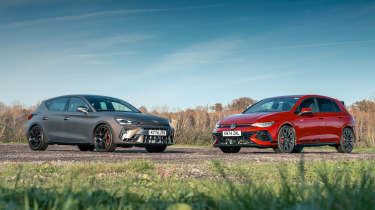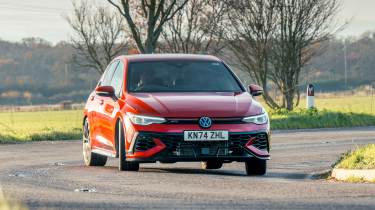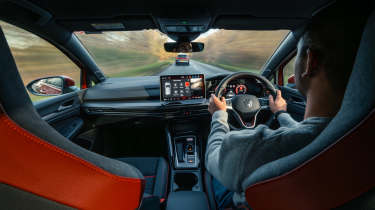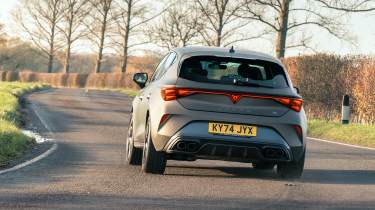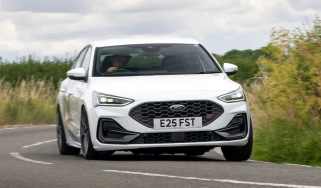Volkswagen Golf GTI Clubsport v Cupra Leon 300 – what's the best mainstream hot hatch?
As high-priced heroes steal the headlines, a real-world hot hatch battle rages between Volkswagen’s refined Golf GTI Clubsport and Cupra’s rebellious Leon 300. Which delivers the better blend of thrills and practicality?
Who makes the best hot hatchback on sale? Spoiler: it isn’t Volkswagen or Cupra. Rather, the likes of the Honda Civic Type R, Audi RS3 and Toyota GR Yaris are at the apex of hot hatch engineering and driving thrills right now, redefining what can be extracted from humble underpinnings. But they also come with some major caveats. At £50k the Honda is out of reach for most traditional hot hatch buyers, and the RS3 creeps into a space occupied by full-blown sports cars with its £60k asking price. And the Yaris? Good luck ordering a new one. Even if you can, you’ll be handing over £44,250 for a three-door supermini that’s somewhat limited for daily tasks.
So what about the best archetypal hot hatch? One that sticks to the classic formula and blends speed and usability for a more sensible price, without any major shortcomings? That’s where Volkswagen and Cupra elbow their way back into the conversation.
The Golf GTI set the blueprint for the class, of course, rarely being the most exciting but often being the hot hatch that you’d most want to live with day to day. That was never more true than with the ultra-slick and competent Mk7 generation, but the Mk8 that followed wasn’t as desirable, starting off on shaky ground with poor ergonomics and a reduced sense of quality. The latest Mk8.5 is a step forward, with its upgraded interior and a fine-tuned chassis, the Clubsport version topping the tree with 296bhp (35 more than standard) and a keener edge to its dynamics. But before it can reclaim its place as the de facto do-it-all hot hatch, it has rivals to deal with – including some friendly fire from elsewhere within the Volkswagen Group.
More reviews
In-depth reviews
- Used Volkswagen Golf GTI (Mk5, 2004 - 2009) review – one of the best VWs of the last 30 years
- Volkswagen Golf GTI 2025 review – the quintessential hot hatch improved but not perfected
- Volkswagen Golf R 2025 review – Mk8.5 not the return to form we'd hoped for
- Used VW Golf GTI (Mk7, 2013 - 2020) review – still the best hot hatch all-rounder
Reviews
Cupra’s Leon 300 recently received its own mid-life update, and is underpinned by the same platform and mechanicals as the GTI Clubsport but with a more striking body and a different flavour to its chassis set-up and overall character. The two are evenly matched on price, too, each starting from c£42k. This in-family feud has been going on since the days of the Mk1 SEAT Leon Cupra and Mk4 Golf GTI, and as of late the Spanish firm has made a habit of producing more interesting and exciting hot hatches from the same ingredients as Volkswagen. Is that still the case this time around?
Beginning in the Golf, I take the cross-country route to its meeting with the Cupra, and boy is it slippery. Temperatures are near freezing, the road is damp from last night’s rainfall, and as I settle in and pick up speed, the GTI’s front Goodyears aren’t finding any bite, skipping across the surface on tighter sections of road. Soon the engine is warmed through and I start exercising it more, but so little of the power is usable I might as well be in a TDI. After a flare of involuntary wheelspin over a bump in third gear I back off and wonder whether this will be a test of the tyres more than the cars.
Managing editor Ian Eveleigh awaits in the Hankook-shod Cupra, which you’ll recognise from our Fast Fleet pages, and seems to have had similar adventures. ‘This has no grip this morning, and no feel whatsoever,’ he says. But parked next to the Golf, what the Cupra does have is a much more interesting shape that pulls your eyes away from the low-key Volkswagen. This car’s matt brown paint helps (it looks better than it sounds), as do the copper-coloured wheels and this facelifted version’s redesigned snout. Peer through the window and you’ll notice a set of carbon bucket seats, too, which is pretty much unheard of in this class. It all gives the impression of a much more exuberant car than the Golf, but then exuberance has never really been the GTI’s style.
I stick with the Volkswagen initially, and as the temperatures climb it starts to wake up a bit. What immediately comes across is how mature it feels for a hot hatch. There’s a calmness to how it drives, evident in the relaxed responses from the steering, the flexibility of the 2-litre EA888 motor and the compliance over tricky surfaces with the 15-stage adaptive dampers wound to their softest setting. It’s very easy to get along with, but there’s none of the inherent sparkle and sense of deep-seated quality you feel in your first few miles in a Civic Type R. The Golf feels more conventional, more like a warmed-up hatch than a finely honed driving tool.
That’s not to say there isn’t fun to be had. Push hard and typical hot hatch traits emerge, the Golf digging in to find grip and occasionally pivoting around its nose if you back sharply off the throttle. Get back on the power and you feel the electronic differential lock nibbling away to find traction, before hooking up and launching you down the road when the turbo wakes up. Through damp corners shaded by trees there’s an awful judder through the car under hard throttle that makes it feel scrappy, but you can drive around this by setting the car up for a straighter exit and blending in the power smoothly. A Golf R would indisputably be a more effective tool for picking apart these roads at speed, but there’s something to be said for how the lighter, simpler Clubsport makes you think and work up to its potential. It’s quick too. Pick-up is crisp with the powertrain in Sport and there’s real guts to the mid-range, accompanied by a parpy (but not exactly musical) four-cylinder blare from the titanium Akrapovic rear silencer, which comes as part of the £3360 GTI Performance package. This bundle also brings 19‑inch wheels (up from the standard 18s), a raised 168mph speed limiter and an extended rear spoiler. Being a Clubsport, it seems a bit mean that these aren’t thrown in as standard.
This Cupra has some fancy equipment too, being the top-spec VZ3 version. This includes the aforementioned 19-inch copper alloys, upgraded Akebono brakes with six-pot calipers and 375mm discs at the front, plus those carbon seats. Add in the matt paint and a panoramic glass roof as fitted here and the price shoots up to almost £51k. Ouch. From inside it does feel more special than the rather plain Golf, though. Drop into the fantastically supportive seats and you’re greeted with a bit more glitz and interesting material choices – some of which work well (the stitched dashboard and copper details), others not so much (the cheap-looking faux carbon on the steering wheel). Front and centre on the dash is the same huge infotainment screen as in the Golf, which looks like it’s been ripped off a decent-sized laptop. In both cars, the size does make its information clearer to see and gives you bigger icons to aim at with your finger, but working your way around the various sub-menus still draws your eyes away from the road.
The Cupra’s 2-litre engine is in the same 296bhp state of tune as the Golf’s, but it’s a little more subdued and less vocal, even with the noise ramped up in the drive mode menu. But that’s about the only area where the Leon feels less lively than the GTI, because from the moment you get moving, it feels more connected, more frantic and a little rougher around the edges – in an entertaining kind of way. It rides on Hankook’s Ventus S1 evo3 tyres, which seem to find less bite than the Volkswagen’s Eagle F1 SuperSports and need more careful management of the throttle to avoid wasteful wheelspin. Likewise the rear can kick wide more readily if you turn in while holding the brakes into the apex. These sound like vices, but your inputs have a bigger influence than they do in the more stable Golf, and that makes it more fun.
With the weak sun managing to dry the road in places, there’s a little more feedback too, although neither car gives you confidence to nudge up to the limit on a slippery surface. You tend to drive on trust rather than feel, but the Cupra’s steering is more positive than the Clubsport’s, while the brakes have a more solid, reassuring bite at the top of the pedal. You’re probably not going any faster than the Golf – in fact you’ll be left behind in damp traction zones – but you feel more dialled in, and it’s that bit more involving. It’d be more involving still with three pedals, of course, but both the GTI and the Leon are DSG-only these days. There’s no consolation of tactile paddleshifters, either, because you get cheap-feeling plastic ears behind the wheel in both cars. The seven-speeder that they command is a slick-shifting ’box, but downshifts can take a couple of tries when you’re ‘coming in hot’, as the gearing means there sometimes aren’t enough spare revs to slot into a lower gear when you expect there to be.
So the Cupra is undeniably more exciting, but jumping back in the Golf does allow you to relax more and take a breath, carrying speed more easily. As dry patches emerge, the chassis starts talking to you more, the steering building up a more convincing sense of load and the body leaning onto the outside-front tyre to find grip and keenly hook into the apex. You can get into a fast and satisfying rhythm with it, and while it’s still not completely absorbing, there’s real speed and capability beneath the Golf’s veneer of usability.
But the Cupra can play the relaxed everyday role too. As we’ve discovered from running this example on the Fast Fleet, it’s a really pleasant car to live with and can be completely undemanding to drive, exactly as a multi-faceted hot hatch should be. Though the Golf does ultimately feel more subdued and sophisticated, the Cupra can also be dialled back to become a tamer hatch. With the same 15 stages of damping adjustment as the GTI you can slacken the dampers right off, but somewhere between Comfort and Performance (respectively the fourth and eighth notches along the slider) is best to avoid an awkward bobbing sensation over bumps. So configured, the Cupra is supple but with a firm edge, and you can dull the engine noise to let miles slip by more quietly. Then when the right road presents itself, that extra aggression and eagerness is one or two taps away. It’s a really rounded product.
More rounded than the GTI? Perhaps not, but the Cupra certainly delivers higher peaks without sacrificing overall usability. It has more personality than the Golf and makes you wonder whether Volkswagen has left too much on the table for what should be its all-singing, all-dancing, most-focused GTI. As it stands, the Cupra is the king of Volkswagen Group hot hatches, and though it’s a very hard sell when specced-up to Civic Type R money as per this test car, at £42k it’s one of the best hot hatches you can buy full stop.

